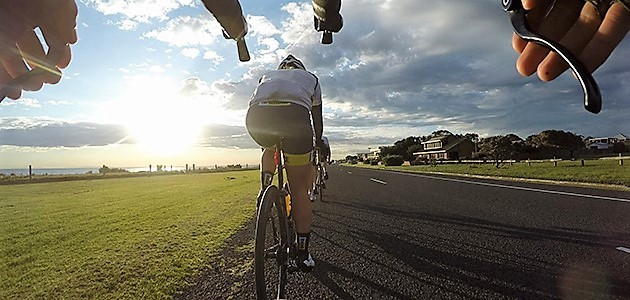
In a triathlon, you spend the most amount of time on your bike. At Tri-Alliance, our Road Cycling Tips will help you better understand and adhere to cycling road rules and general bike etiquette when you’re on a group ride with Tri-Alliance.
Bike Safety and Ethics
It is important to make yourself aware of road cycling rules, safety and ethics – particularly if you want to start riding in groups (referred to as ‘packs’), which is what we do at Tri-Alliance.
“Cyclists have the same rights and responsibilities as other road users. Whatever vehicle you drive, the golden rule is to treat other road users with respect and courtesy. All road users should drive or ride safely and obey the traffic rules at all times. Click here to view Bicycle Network’s overview of road rules.
When riding on roads involving traffic, other bikes and pedestrians, it is very important to have knowledge of the road rules and ways to decrease the chance of an accident. Even if you are following the law, it is still important to know what to look out for as others on the road might not be doing the right thing.
When cycling with Tri-Alliance organised group rides, it is paramount that you observe our cycling rules. This includes signalling by voice and by hand, and also extends to ensure you are riding two abreast in an orderly fashion (no half-wheeling or sitting too far off) unless you are in a single file.
Here are some tips to improve your safety on the road:
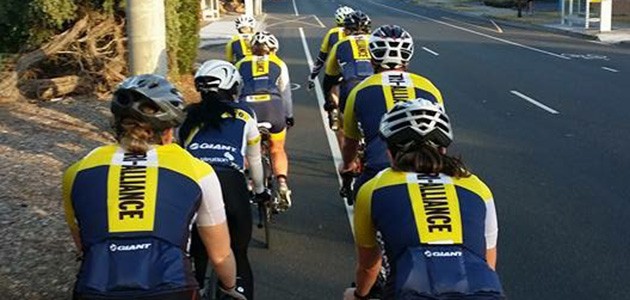
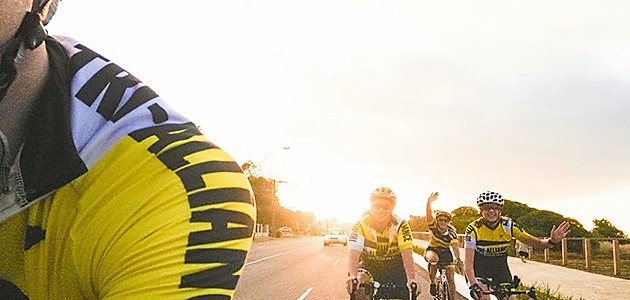
Road Cycling Tips
- Ride either in single file or 2 abreast only (if 2 abreast, must be within 1.5m)
- When riding two abreast, ensure you are not half-wheeling the person in front of you
- When riding two abreast, ensure that you are not too far off the back of the rider in front of you, as it breaks up the orderly fashion on the group
- Ensure you ride directly behind the person in front of you. Not out to the side where you become an obstruction for other cyclists and bring safety into disrepute for your group.
- If you do not feel confident to stay close to the wheel in front of you, move to the back of the group at let other riders in your group know. It is for the safety of your group that you communicate.
- If you are overtaking a group which is 2 abreast, overtake in a single file and make sure it is safe to do so
- Stop at all red lights (you are slower than when you are driving; take this into account)
- If there is a bike lane, use it unless it is unsafe to do so
- If it is dark or dawn/dusk or low visibility (i.e. fog) use front and rear lights (red / yellow reflector vests are great as well)
- Indicate clearly if you are turning
- Keep as far left as is safe to do so
- Always keep an eye out to see what is going on around you: other bikes, cars coming up from behind, pedestrians, dogs, kids, trams, buses, etc.
- Make sure you are looking further up the road: traffic lights, parked cars, pedestrian crossings
- Try not to ride in driver’s “blind spots” – a lot of drivers will not notice bicycles
- Be careful of road works or detours
- Ride with someone (or in a group)
- Have a mobile phone (phone numbers of other riders) and cash (or credit card) for emergencies
- Ask your coaches (or experienced riders) for tips or advice
- Point to any noticeable ditch/pot hole or alike
- With an open hand, wave toward any glass/loose gravel (yell “GLASS” if dangerous amounts)
- To ride in single file, raise your inside arm and hold one finger in the air (general rule: the outside rider moves in front of inside rider)
- When slowing, lower your inside hand with your palm facing the riders behind
- Yell “Lights Up” if the lights a long distance ahead have changed to yellow or red
- Yell “Stopping” if the lights have just changed in front of you
- Yell “Rolling” if you had been slowing and it is then safe to continue
- Yell “Car” if you are approaching a round about and a car is approaching – this alerts those further down the pack
Bunch Riding and Cycling Etiquette
Weekend road rides form an important part of your winter training. These rides aim to improve your bike skills, endurance and strength. At the same time, safety is paramount to us and due to large numbers who attend our group rides we need to ensure every rider is aware of the procedures and etiquette of riding in a bunch.
Every rider has different skills and ability. A strong rider does not necessarily have strong bike handling skills or judgement on the road. So it is important that every rider learns the art of bunch riding to help ensure a safe riding environment for all riders. Particularly on busy (and often dangerous) streets in and around Melbourne.
Becoming a proficient bunch rider takes time and experience to achieve. The key to a safe ride is to always be aware of the conditions we find ourselves in, and to react accordingly. Most important is consideration of the riders around us: what they are doing at any given time, and their level of skill. And of course we need to be continually aware of the road and traffic conditions.
It is also paramount that you do not present a safety risk to you group this includes;
- Wearing prescription glasses or contacts if applicable
- Cycling further out to the side than the rest of the bunch, causing an obstruction to other road users and your group
- Cycling further back in the bunch (when you are not the last rider), causing other cyclists in your group to fall out of their orderly two-abreast ride.
- Calling out road obstructions such as; “riders back”, “car back”, “car up”, “lights up”, “slowing”, “stopping”, “rolling”, “single file”, “clear”, “pot hole”, “glass” etc.
- Pointing out road obstructions by using the correct hand signals that demonstrate the following; overtaking, rough surface, matter on the surface, turning left or right, single file, slowing etc.
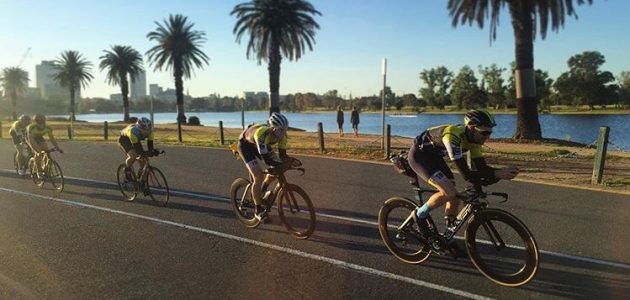
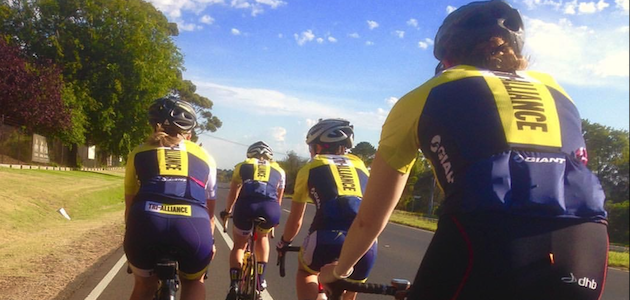
Group Riding Tips
Riders should pair in two’s riding around 30-60cm off the wheel in front.
Ensure the group is always to the left of the road. This ensures other riders and motorists can pass safety. Only ever pass other riders on the right hand side only. This also means that when in a group ride scenario, riders are two-abreast (unless single file is necessary), and ensure that adequate wheel to wheel distance is kept, and no riders are half-wheeling or falling out further to the right.
The lead riders have a big responsibility. They set the pace, call for obstacles on the road etc. So never forget the group of riders behind you. Every rider behind must then pass that same message down the pack of riders (think of Chinese whispers)
Lead riders have the responsibility of making a ‘call’ on upcoming lights. Options include “lights/stopping” or “rolling“. Remember your bunch is one vehicle – so if the lead riders ‘roll’ then so does the rest of the bunch. This is why it is safe to keep bunches to around 12-15 riders.
Options include “clear” or “car up/stopping“. Calls must then be relayed down the bunch.
The riders at the back of the bunch also have a big responsibility – particularly the ones on the right hand side. This person/s must warn lead riders of traffic coming from behind when on a single lane or narrow/tight roads. Calls include “car back/wait” or “ok/clear back” . Instructions must then be relayed to the front of the bunch.
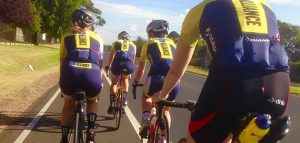
Depending on the group and what is designated for the ride, lead riders should roll turns at regular intervals and when it is safe to do so. Never roll
turns going up hill or into lights/intersections. When a roll over is to occur, the front two riders agree on a safe section of road and roll off together. Both riders roll right, and form a single file on the right hand side of the bunch. These riders will soft pedal until the reach the back of the bunch. The bunch should not change pace at all during the roll over, it is the lead riders who roll off who slow down.
Avoid braking or changing direction suddenly. Remember that there are riders following you closely from behind.
These include potholes, drain grates, stray animals, opening car doors, sticks or stones, parked cars, gravel, glass etc.
A slight direction change or gust of wind could easily cause you to touch wheels and fall.
When you are at the front of the bunch always pedal downhill. Cyclists dislike having to ride under brakes. If you freewheel down hill you are doing as much good as sitting in your lounge chair.
Avoid surges and sudden changes in pace. A group will travel quicker when turns are completed smoothly.
Cyclists save about 30% of their energy at high speed by following a wheel. Each time you leave a gap you are forcing yourself to ride alone to bridge it. Also, riders behind you will become annoyed and ride around you.
Avoid following a wheel too closely. Many riders often lose their momentum when rising out of the saddle on a hill which can cause a sudden deceleration. This can often catch a rider who is following too closely, resulting in a fall from a wheel touch.
Remember what you do affects others so be predicable with your actions. Those towards the back of a bunch feel the effects of every riders actions. So keep this in mind.
Do not panic if you brush shoulders, hands or bars with another rider. Try to stay relaxed in your upper body to absorb any bumps. This is a part of riding close bunches and is quite safe provided riders do not panic, brake or change direction.
“Clear left/right”
Used when attempting to join the flow of traffic from a T-section or roundabout to indicate that the road is clear and the group can begin to move through the junction without stopping but, crucially, after slowing to check for traffic. As a result, this call should only be used when the T-section or roundabout offers a clear line of sight in both directions.
The absence of this call indicates the default position that a vehicle is approaching, and that it’s unsafe to pull out of the junction or across the split road. Some riders also use a “car left/right” call to emphasise the presence of traffic in this situation, but make the call loud and understandable so not to confuse “car” with “clear”.
“On the left/right”
For use between cyclists, this warns a rider in front of you where you are in relation to them on approach. For example, calling “on the right” as you approach a slower cyclist from their right flank, and vice versa.
“Car up”
Warns of a car approaching from up the road, usually actively travelling towards the group. This call is used when the road is narrower than a dual-direction single carriageway with enough space for vehicles to pass each other without avoiding action.
“Car back”
Warns of a car approaching from the rear of the group, which means it’s also the only call which originates from the rear of the group.
As a result, it’s vital to call clearly so that other group members hear and pass it up the line as your voice won’t travel as far forward against the flow of the bunch. Variations as with “car up” can be used, but in reality are only needed very rarely.
Slowing
With your arm outstretched, palm-down, and slightly behind you so cyclists behind you get a clear view of your hand, move your hand up and down at the wrist to indicate that you’re about to slow. Use this indication when you’re confident that you’re going to be pulling the brakes in order to significantly slow your speed.
Optional call: “Slowing!”
In addition to the signal, and if braking is more urgent and you haven’t got time to indicate safely, call out “Slowing!” loudly and sharply. This will give riders an additional stimulus to react to, apart from your rear wheel suddenly rushing towards them.
Stopping
Raise a hand straight above your head to indicate that you expect to stop. This indication supersedes the indication and call to slow.
Optional call: “Stopping!”
While optional, the call of “Stopping!” can be absolutely necessary if the nature of the stop is sudden or sharp, and if you therefore haven’t got the time to make the signal. This can make the difference between a safe stop and a potentially very dangerous situation, so ensure the call is loud, sharp and urgently made with as much notice as possible.
Indicating
An essential signal for all road users. Outstretch your arm straight out to the side of you to indicate your intended turn. Ensure you make this indication before you edge out to the middle of the road in the case of a right turn, so other road users have plenty of notice of your intentions. Always have a quick look behind you to make sure those other road users have seen and reacted to your indication.
If you’re at the head of a large peloton, it can be helpful to raise your hand to just above shoulder height, and point in the direction of the upcoming turn.
Pothole or hazard on road
If you are approaching a hazard in the road, for example a pothole, manhole cover or drain cover, outstretch your arm on the side that the upcoming hazard will pass your bike and point to the floor. This will sometimes be accompanied by a circling motion – if there’s time.
Optional call: “Hole!”
For deep and sharp holes in the road, a clear and loud call of “hole” or “holes” will help notify your fellow cyclists of the severity of the upcoming obstacle.
Oncoming hazard
As you approach a physical oncoming hazard, take the arm on the side of the hazard behind you and point across your back in the direction the cyclist behind you will need to move in order to avoid it.In Australia, the hazard usually approaches on the left in the form of a parked car or similar, so the left arm is normally used
Gravel/debris
For specific hazards where the effect will be a potentially slippery surface, take your outstretched hand, palm down and wave at the floor. This can also be used for a broken or unconsolidated road surface.
Optional call: “Gravel!/Glass!/Branch!/etc.”
Calling out the nature of the hazard loudly can add extra important information to your fellow cyclists. Ensure you use clear, single word calls to avoid confusion.
Come through
We’ve all been there, where we’ve been doing far more than our fair share of the work at the front of the group, and have seemingly been left out to dry.
While riding, flick your elbow out on the side you want the wheelsucker(s) to come through. Emphasise this by safely moving out slightly to give them extra room to come by, and ease off the pedals very slightly; they’ll get the message.
Thanks/acknowledgement
It’s so easy to forget to do this, but makes the world of difference for road-user relations. If an oncoming vehicle has let you and/or your group have space to make a turn or have access to a narrow stretch of road first, acknowledge them with a raised hand of thanks. Making this sign obvious – for example with an additional smile or a raised thumb – can help ‘humanise’ you on the road, and conveys genuine appreciation for the actions of the other road user.
It’s also a fine road cycling tradition, especially in Australia, that road cyclists acknowledge each other as they pass by. A nod of the head and smile, or a hand raised off the ‘bar, will do the trick for oncoming riders, or just say “hello” if passing a cyclist on the same side of the road. Be nice out there!
